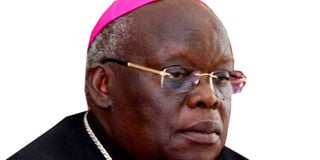Clarification on apostolic succession in Catholic and Orthodox churches

John Baptist Odama
What you need to know:
- Regarding Kibuuka’s group, the similarity of its liturgy to the Roman rite is notable and wrong.
- No genuine Eastern Catholic Rite uses vestments of the Catholic Roman Rite. Furthermore, their way of dress and liturgy is quite different from ours.
The consecration of the self-excommunicated priest Jacinto Kibuuka to the position of a bishop has raised many questions in the public. The basic question that is emerging pertains to the authenticity and validity of this consecration as seen from the point of view of Antiochian Orthodox Church and the 23 independent churches within the Catholic Church led by Pope Francis.
Indeed this question should be examined from the above two points of view since Kibuuka has at one time claimed to be part of the Antiochian Eastern Catholic Church, which is in communion with Pope Francis and at other times claimed to be part of the Antiochian Orthodox Church, which is led by His Beatitude John X (Yazigi), successor of His Beatitude Ignatius IV.
So far, it is clear to us all that he does not belong to the Antiochian Eastern Catholic Church (presided over by His Beatitude Moran Mor Ignatius Joseph III Jonan) since as stipulated in the 1983 Code of Canon Law, canon 112, § 1, 10, a Roman Catholic needs the permission of the Pope to cross over to any Eastern Catholic Church, which permission he lacks.
As far as the validity and authenticity of Episcopal Consecrations in the Orthodox and Catholic Churches are concerned, the apostolic lineage/succession is of paramount value. The notion of succession/ lineage is not foreign even to many of our cultures in Uganda. For example, in the Baganda culture, it is brought out in the Okulanya, in which one spells out his parents, grandparents, great grandparents and so on, so as to prove his or her right of belonging to a particular clan and family.
“Apostolic succession” refers to the lineage from the 12 Apostles to the current bishops in the Orthodox and Catholic churches. This lineage is very important in evaluating the validity of Episcopal Consecrations. The 12 Apostles laid their hands over their successors and prayed over them, hence, consecrating them bishops (Acts 1: 19-26; Acts 13:1-3; I Tim 1:18-20; 1 Tim 4: 14; 1 Tim 3:1ff). These in their turn also laid their hands over their successors and prayed over them and the line continued up to the present day Catholic and Orthodox bishops.
The Uganda Episcopal Conference would like to enlighten the public on the lack of apostolic succession in Evangelical Orthodox Church and challenge Kibuuka and his group to prove with documentation from the Antiochian Orthodox Patriarch, the claims that one of the Evangelical Orthodox Church bishops was consecrated in the Apostolic lineage within the Antiochian Orthodox Church.
The bi-annual book, Orthodoxia, published for many years now by the Institute for Ecumenical Studies of the University of Fribourg-Switzerland, in which all the Genuine Orthodox churches are recorded, with all orthodox bishops, who bear this privilege of Apostolic succession and the Annuario Pontificio 2017, in which all the Eastern and Western Catholic Bishops with Apostolic succession are recorded, do not mention the Evangelical Orthodox Church. The two documents are available at the Byzantine Orthodox headquarters at Namugona and the Vatican Embassy in Uganda. The Orthodoxia can also be accessed on the Internet(see: http://www.orthodoxia.ch/en/page 5/ show).
Regarding Kibuuka’s claims that he has joined the “Antiochian Rite” and is thus in communion with the Pope, it should be noted as stated earlier that no one can change from one rite to the other by personal declaration. The permission of the Holy See is required as canon 112 § 1, 10 clearly states.
Any such permission would be granted only through the Apostolic Nunciature following prior consultations with the local bishops concerned, but none has ever been granted and would not be granted without consulting the Bishop Ordinaries concerned.
Regarding the “Antiochian Rite” or, more correctly, Oriental Rites of the Antiochian Tradition, this is a term that refers to three distinct Eastern Churches: the Malankar (from India), the Maron (from Lebanon) and the Syrians (from Iraq and Syria) - each of the three has its own Patriarch or Major Archbishop. Brief descriptions about the Antiochian Rite can be found in the Annuario Pontificio 2017. There is no generic “Antiochian Rite” to which one adheres. Therefore, one wonders and asks - which of the three Patriarchs has welcomed Kibuuka?
Regarding Kibuuka’s group, the similarity of its liturgy to the Roman rite is notable and wrong. No genuine Eastern Catholic Rite uses vestments of the Catholic Roman Rite. Furthermore, their way of dress and liturgy is quite different from ours.
Kibuuka apparently did not realise that elements of Eastern traditions are also in the revised Roman Rite since the publication 40 years ago of the Fourth Eucharistic Prayer, which is a variation of the most widely used anaphora in the Eastern churches. Let Kibuuka and his group stop misleading the innocent faithful with false doctrine.
Lastly, the statements made last February by the “presiding Patriarch” of the Evangelical Orthodox Catholic Church, Jerold Gliege, concerning the project of introducing Ugandans to Orthodox spirituality and liturgy, are very perplexing since the Uganda Orthodox Church, has been present here for many years, and the Apostolic Succession of its Metropolitan Archbishop is recognised by the Catholic Church.
I hope that this information helps the faithful to grow in communion with their legitimate pastors. The Uganda Episcopal Conference remains disposed for further clarification.
Yours in Christ,
The Most Rev Odama is the Archbishop of Gulu and chairman of Uganda Episcopal Conference.




